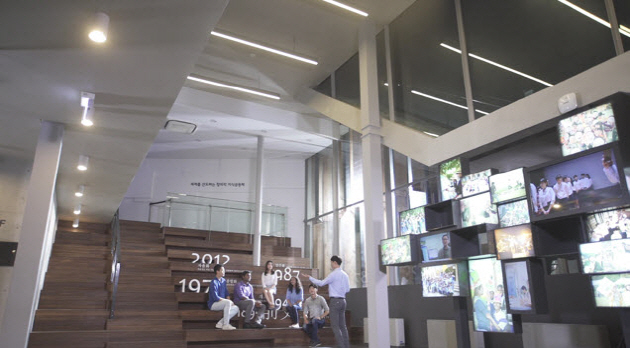
SNU students in discussion
Author Edward de Bono defines creativity as “breaking out of established patterns in order to look at things in a different way.” Professor SeJik Kim of the Department of Economics, also a member of the new Faculty Group for Creative Education, implements this in his Money and Finance course, where students are presented every week with unusual questions that challenge them to think creatively. For example, students are asked to ponder, “There is an island that uses stone as its currency. Explain what money is.” Students claim that they “brood over these questions day and night because they are so perplexing.” Professor Kim reminds his class that “there is no right answer” to these questions, and the assignments have no structure or word limit. The intention is to encourage students to think of unique and original answers.
The midterm and final exams for the course also incorporate creative thinking. Along with traditional questions with answers that are either right or wrong, Professor Kim includes questions where he encourages students to “unleash the wings of your imagination and answer as creatively as you can.” The Fall 2016 midterm proposed, “In ‘Fire Land,’ where the temperature is always above 30°C, what would be the most effective method of adopting ice as its currency?” and “What would happen if the government imposed a ban on loans?”
Students unused to this style of learning would answer these questions using conventional economic theories, but Professor Kim gives the highest marks and praise to students whose answers are imaginative while at the same time logical. Sang-Hwa Ahn, a student in the course, said that “this course was very different from other courses that emphasize the importance of creativity, but in reality do not give high grades to answers that do not align with the professor’s standard expectations.”
After being trained every week to think outside the box, students began to provide innovative answers that “broke out of established patterns.” The responses that received the best marks to the question about the ‘Fire Land’ were: “Invent a new form of ice that does not melt in high temperatures,” and “Simply change the name of the current currency to “Ice.” The logic for this latter answer is that currency is based on the elements of trust and agreement, so it does not have to be actual ice.
Professor Kim was inspired to adopt creative learning in his teaching when he returned to Korea in 2006 after completing his studies in the US, and was greatly disappointed that SNU still used rote-learning methods that only encouraged students to memorize. He thought that “the driving force of Korea’s economic development is the people, but if we continued to educate them this way, the economy will only deteriorate.”
Teaching a course like this is challenging for the professor as well. Professor Kim said that thinking of questions and grading the answers is extremely time consuming, and some students complain about the evaluation criteria. While he receives very little benefit from incorporating these elements into his course, Professor Kim believes that creative minds are crucial for the nation. “Without them,” he says, “there will be no future for Korea.”
While it is difficult to evaluate the effectiveness of courses such as Professor Kim’s, most students reported that their creativity had improved after taking his class. Asked to evaluate their creativity on a scale of one to ten at the beginning and end of the semester, 33 out of the course’s 36 students last semester reported an improvement in their creativity, with an average increase of 1.8.
Yoon-Sang Kim, another student in the course, described the class as “our very own playground,” where students felt free to attempt new things. “After we began to trust that the professor would accept even our most outrageous responses, we all became competitive in our attempts to be unconventional.”
Written by Hye Bin Lee, SNU English Editor, hahahybes@snu.ac.kr
Reviewed by Professor Travis Smith, Department of Asian Languages and Civilizations, tlsmith@snu.ac.kr

